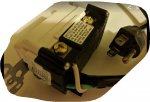brycenesbitt
Senior Member
- Location
- United States
Anyone seen this? I'm looking at a laundry room, where the AFCI breaker trips if any large load is placed.
It was reported as on the spin cycle of the washer. I was able to repeat the issue using an Instant Pot -- the moment the heater element kicks in, the AFCI trips, showing an arc fault.
The GFCI is a Leviton 07599. Siemens/Murray AFCI breaker.
Swapping for a new GFCI and all seems to work. I seem to have the worst AFCI experiences in laundry rooms!
It was reported as on the spin cycle of the washer. I was able to repeat the issue using an Instant Pot -- the moment the heater element kicks in, the AFCI trips, showing an arc fault.
The GFCI is a Leviton 07599. Siemens/Murray AFCI breaker.
Swapping for a new GFCI and all seems to work. I seem to have the worst AFCI experiences in laundry rooms!
Last edited:



